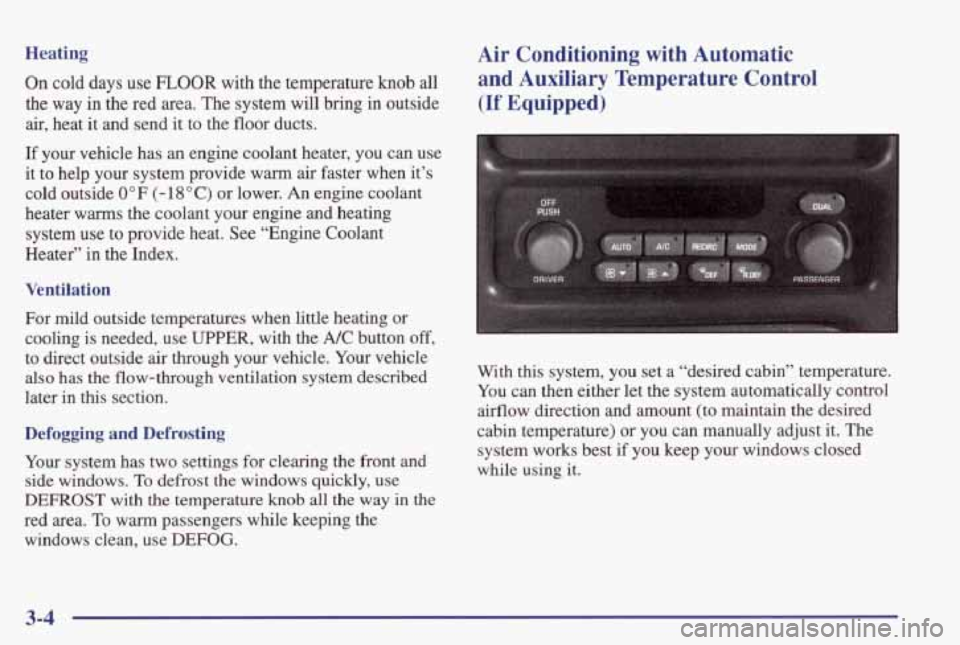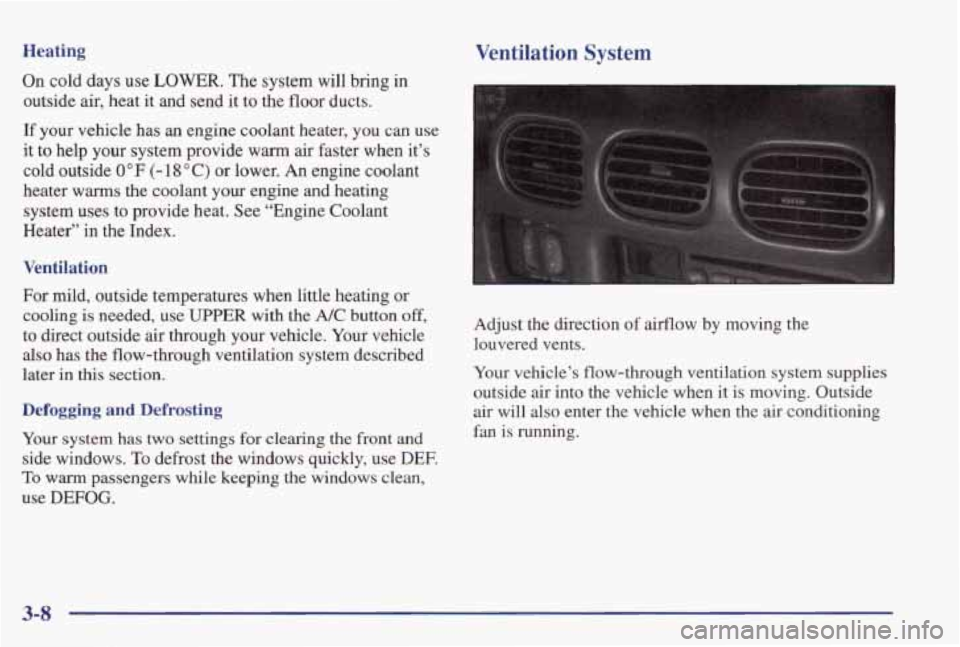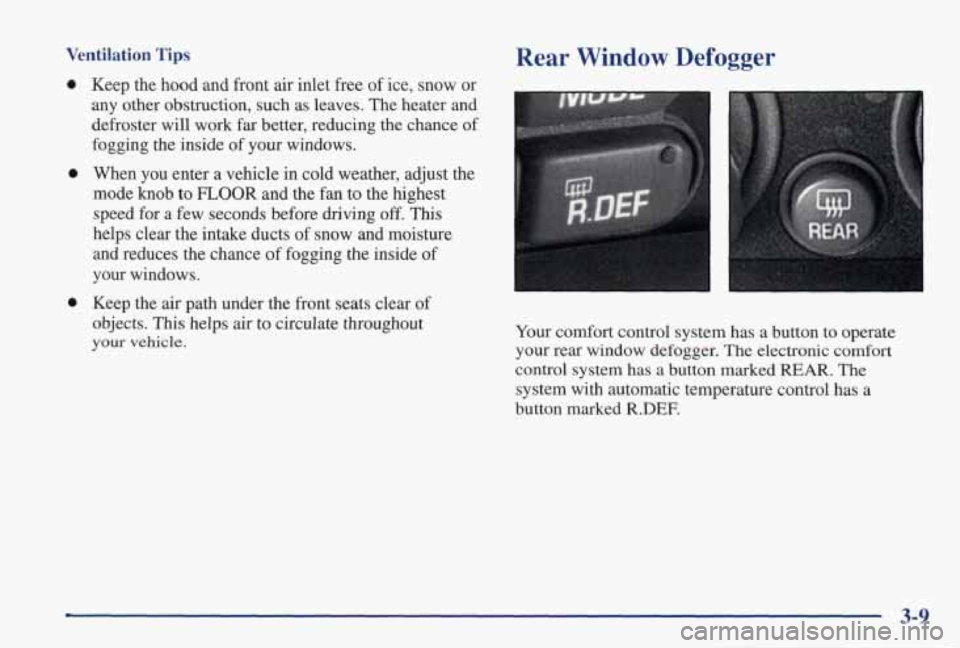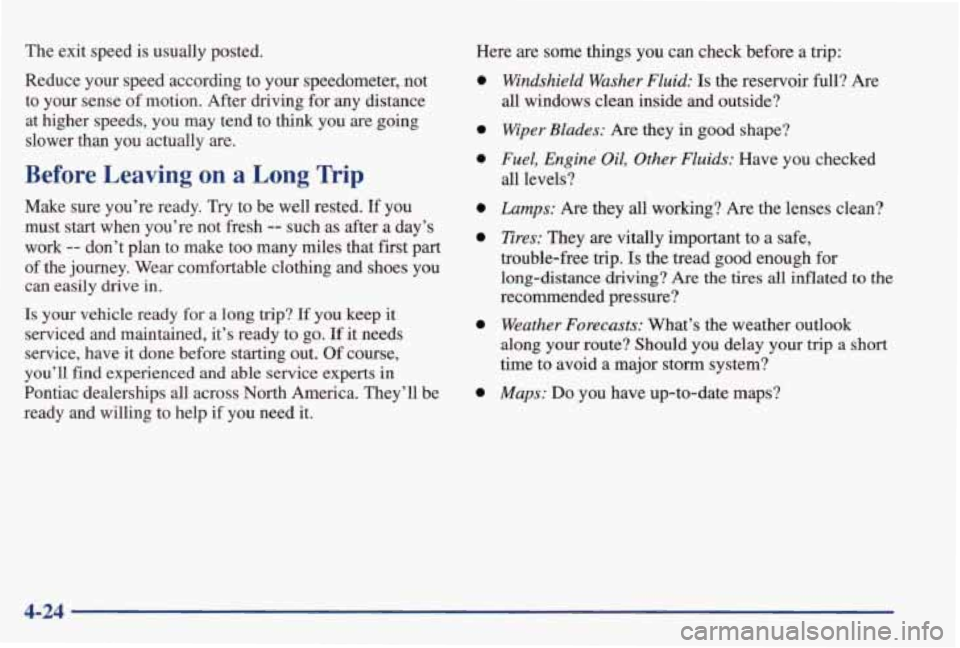1998 PONTIAC GRAND PRIX window
[x] Cancel search: windowPage 162 of 402

0
+# FLOOR: This setting sends most of the air
through the ducts near the floor. The remaining airflow
comes out of the defroster and side window vents.
?d DEFOG: This setting allows half of the air to go
to the floor ducts and half to the defroster and side
window vents.
w
DEFROST This setting directs most of the air
through the defroster and side window vent. Some of the
air goes to the floor ducts and the side window vent. The
air conditioning compressor will run automatically in
this setting unless the outside temperature is below
38°F (3.3"C).
Air Conditioning Compressor Button
Press the A/C button to operate the air conditioning
compressor. The indicator light above the button will
glow when the button is pressed. You don't have to
press the button to run the compressor in
MAX or
DEFROST because it will already be running in
these modes.
Air Conditioning
On very hot days, open the windows long enough to let
hot, inside
air escape. This reduces the time for the
vehicle to cool down.
For quick cool-down on very hot days, use MAX with
the temperature knob all the way in the blue area. If this
setting is used for long periods of time, the air in your
vehicle may become too
dry.
For normal cooling on hot days, use UPPER with the
temperature knob in the blue area and the A/C button
pushed in. The system will bring in outside
air and
cool it.
On cool, but sunny days, the sun may warm your upper
body, but your lower body may not be warm enough.
You can use
BI-LEVEL with the temperature knob in
the middle and the
A/C button pushed in. The system
will bring in outside air and direct it to your upper body,
while sending slightly warmed air to your lower body.
You may notice
this temperature difference more at
some times than others.
3-3
Page 163 of 402

Heating
On cold days use FLOOR with the temperature knob all
the
way in the red area. The system will bring in outside
air, heat it and send it to the floor ducts.
If your vehicle has
an engine coolant heater, you can use
it to help your system provide warm
air faster when it’s
cold outside
0 OF (- 18 O C) or lower. An engine coolant
heater warms the coolant your engine and heating
system use to provide heat. See “Engine Coolant
Heater”
in the Index.
Ventilation
For mild outside temperatures when little heating or
cooling
is needed, use UPPER, with the A/C button off,
to direct outside air through your vehicle. Your vehicle
also has the flow-through ventilation system described
later in this section.
Defogging and Defrosting
Your system has two settings for clearing the front and
side windows.
To defiost the windows quickly, use
DEFROST with the temperature knob all the way in the
red area. To warm passengers while keeping the
windows clean, use
DEFOG.
Air Conditioning with Automatic
and Auxiliary Temperature Control
(If Equipped)
With this system, you set a “desired cabin” temperature.
You can then either let the system automatically control
airflow direction and amount (to maintain the desired
cabin temperature) or you can manually adjust it. The
system works best if
you keep your windows closed
while using it.
3-4
Page 166 of 402

+*
/J UPPER: This setting brings in the outside air and
directs it through the instrument panel outlets.
'# BI-LEV: This setting brings in the outside air and
directs it two ways. Half of the air is directed through
the instrument panel outlets. Most of the remaining air
is
directed through the floor ducts and a little to the defrost
and side window vents.
LOWER: This setting sends most of the air
through the ducts near the floor. The remaining airflow
comes out of
the defroster and side window vents.
+e
w
DEFOG: This setting allows half of the air to go
to the floor ducts and half to the defroster and side
window vents.
DEF: This setting directs most of the air through
the defrost vent. Some of the air goes
to the floor ducts
and the side window vents. The air conditioning
compressor will
run automatically in this setting unless
the outside temperature is below 38°F (3.3"C).
Air Conditioning
On very hot days, open the windows long enough to let
hot, inside
air escape. This reduces the time for the
vehicle to cool down.
For quick cool-down on very hot days, use
RECIRC. If
this setting is used for long periods of time, the air in
your vehicle may become too
dry.
For normal cooling on hot days, use UPPER with the
A/C button pushed in. The system will bring in outside
air and cool it.
On cool, but sunny days, the sun may warm your upper
body, but
your lower body may not be warm enough.
You can use
BI-LEV with the A/C button pushed in.
The system will bring in outside air and direct it to your
upper body, while sending slightly warmed
air to your
lower body. You may notice this temperature difference
more at some times than others.
3-7
Page 167 of 402

Heating Ventilation System
On cold days use LOWER. The system will bring in
outside
air, heat it and send it to the floor ducts.
If your vehicle has
an engine coolant heater, you can use
it to help
your system provide warm air faster when it’s
cold outside
0°F (- 18°C) or lower. An engine coolant
heater
warms the coolant your engine and heating
system uses to provide heat. See “Engine Coolant
Heater” in the Index.
Ventilation
For mild, outside temperatures when little heating or
cooling is needed, use
UPPER with the A/C button off,
to direct outside air through your vehicle. Your vehicle
also has the flow-through ventilation system described
later in this section.
Defogging and Defrosting
Your system has two settings for clearing the front and
side windows. To defrost the windows quickly, use DEE
To warm passengers while keeping the windows clean,
use
DEFOG.
Adjust the direction of airflow by moving the
louvered vents.
Your vehicle’s flow-through ventilation system supplies
outside
air into the vehicle when it is moving. Outside
air will also enter the vehicle when the
air conditioning
fan is running.
3-8
Page 168 of 402

Ventilation Tips
0
0
0
Keep the hood and front air inlet free of ice, snow or
any other obstruction, such as leaves. The heater
and
defroster will work far better, reducing the chance of
fogging the inside
of your windows.
When you enter a vehicle in cold weather, adjust the
mode
knob to FLOOR and the fan to the highest
speed for a few seconds before driving
off. This
helps clear the intake ducts of snow and moisture
and reduces the chance of fogging the inside of
your windows.
Keep the air path under the front seats clear of
objects.
This helps air to circulate throughout
your vehicle.
Rear Window Defogger
Your comfort control system has a button to operate
your rear window defogger.
The electronic comfort
control system has a button marked REAR. The
system with automatic temperature control has a
button marked
R.DEF.
Page 169 of 402

The rear window defogger uses a warming grid to
remove fog from the rear window. Press the button to
turn the rear defogger on. It will turn itself off after
about ten minutes.
If you turn it on again, the rear defogger will only run
for about five minutes before
turning off. You can also
turn it off by pressing the button again.
Do not attach anything like a temporary vehicle license
or decal across the defogger grid.
NOTICE:
Don’t use a razor blade or anything else sharp on
the inside
of the rear window. If you do, you
could cut or damage the warming grid,
and the
repairs wouldn’t be covered by your warranty.
Audio Systems
Your Delco Electronics audio system has been designed
to operate easily and give years of listening pleasure,
You will get the most enjoyment out
of it if you acquaint
yourself with it
first. Find out what your Delco
Electronics system can do and how
to operate all its
controls, to be sure you’re getting the most
out of the
advanced engineering that went into it.
Setting the Clock for AM-FM Stereo
Press SET. Within five seconds, press and hold the
SEEK down arrow until the correct hour appears on the
display. Press
and hold the SEEK up arrow until the
correct minute appears on the display.
Setting the Clock for All Systems Except
AM-FM Stereo
Press and hold HR until the correct hour appears. Press
and hold MIN until the correct minute appears. There
will be a two-second delay before the clock goes into
time-set mode,
and the colon on the display will blink
while in this mode.
3-10
Page 191 of 402

Cassettes are subject to wear and the sound quality may
degrade over time. Always make sure the cassette
tape is in
good condition before you have your tape player serviced.
Care of Your Compact Discs
Handle discs carefully. Store them in their original cases
or other protective cases and away from direct sunlight and dust.
If the surface of a disc is soiled, dampen a
clean,
soft cloth in a mild, neutral detergent solution and
clean it, wiping from the center to the edge.
Be sure never to touch the signal surface when handling
discs. Pick up discs by grasping the outer edges or the
edge of the hole and the outer edge.
Care of Your Compact Disc Player
The use of CD lens cleaner discs is not advised, due to
the risk
of contaminating the lens of the CD optics with
lubricants internal to the
CD mechanism.
Fixed Mast Antenna
The fixed mast antenna can withstand most car washes
without being damaged.
If the mast should ever become
slightly bent, you can straighten it out by hand. If the mast is
badly bent,
as it might be by vandals, you should replace it.
Check every once in a while to be sure the mast is still
tightened to the rear quarter panel.
Backglass Antenna (If Equipped)
Your AM-FM antenna is integrated with your rear window
defogger, located
in the rear window. Be sure that the
inside surface of the rear window is not scratched and that
the lines
on the glass are not damaged. If the inside surface
is damaged, it could interfere
with radio reception.
NOTICE:
Do not try to clear frost or other material from
the inside
of the rear window with a razor blade
or anything else that is sharp. This may damage
the rear defogger
grid and affect your radio’s
ability to pick
up stations clearly. The repairs
wouldn’t be covered
by your warranty.
Because this antenna is built into your rear window, there is a
reduced risk of damage caused by car washes and vandals.
If you choose to add a cellular telephone to your vehicle,
and
the antenna needs to be attached to the glass, be sure
that you
do not damage the grid lines for the AM-FM
antenna. There is enough space between the lines to
attach a cellular telephone antenna without interfering
with radio reception.
3-32
Page 217 of 402

The exit speed is usually posted.
Reduce your speed according
to your speedometer, not
to your sense
of motion. After driving for any distance
at higher speeds, you may tend to think you are going
slower than you actually
are.
Before Leaving on a Long Trip
Make sure you’re ready. Try to be well rested. If you
must
start when you’re not fresh -- such as after a day’s
work
-- don’t plan to make too many miles that first part
of the journey. Wear comfortable clothing and shoes you
can easily
drive in.
Is your vehicle ready for a long trip? If you keep it
serviced
and maintained, it’s ready to go. If it needs
service, have it done before starting out.
Of course,
you’ll find experienced
and able service experts in
Pontiac dealerships all across North America. They’ll be
ready and willing to help if you need it. Here are some things you can check before a trip:
0
0
0
0
0
0
0
Windshield Washer Fluid: Is the reservoir
full? Are
all windows clean inside and outside?
Wiper Blades: Are they in good shape?
Fuel, Engine Oil, Other Fluids: Have you checked
all levels?
Lamps: Are they all working? Are the lenses clean?
Tires: They are vitally important to a safe,
trouble-free trip.
Is the tread good enough for
long-distance driving? Are the tires all inflated to the
recommended pressure?
Weather Forecasts: What’s the weather outlook
along
your route? Should you delay your trip a short
time to avoid
a major storm system?
Maps: Do you have up-to-date maps?
4-24